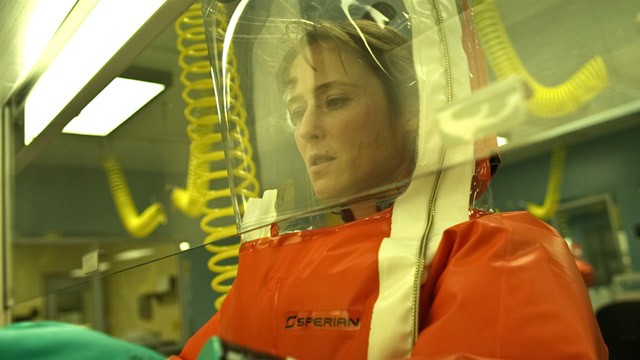You are here
by Kim Carollo - ABC News - September 7, 2011

Jennifer Ehle stars as Dr. Ally Hextall in the film "Contagion." (Courtesy Warner Bros.)
There may not be any zombies, vampires or mutant monsters wreaking bloody havoc on innocent people, but the fact that "Contagion" has a premise that experts say is all too possible may make it the scariest movie of the season.
In the film, a star-studded cast battles a lethal species-jumping virus rapidly spreading sickness and death around the world. Director Steven Soderbergh said in interviews that he aimed for scientific and medical realism in the film. Producers and writers consulted with a number of leading virologists and shot some scenes at the Centers for Disease Control and Prevention (CDC) in Atlanta.
"Based on my knowledge of the movie, it is a dose of realism. It deals with issues that have, what we call in the business of investigating outbreaks, biological plausibility," said Barbara Reynolds, senior adviser for crisis communication at CDC.
"How the virus unfolds in the movie is true to life in terms of how a virus behaves," said Reynolds, who was involved in some of the discussions with Warner Bros.
"The fact that many non-human aspects are covered such as the role of the media, conspiracy theories, transmission, disease surveillance, etc. makes it more plausible," said Dr. Peter Katona, clinical professor of medicine at UCLA's David Geffen School of Medicine.
While the virus and its many victims are entirely fictional, experts say the scenario has the potential to be very real.
"This movie and others like it make a point that we are never safe from emerging and re-emerging infectious diseases. They are a continuous public health threat," said Dr. Ali Khan, Assistant Surgeon General and director of the Office of Public Health Preparedness and Response at CDC.
SARS, Swine Flu Bullets Dodged, Say Experts
A number of well-known outbreaks show that viruses can easily spread from continent to continent and also re-emerge as new strains. The United Nations recently warned of a possible resurgence of bird flu, saying a new strain of the virus is spreading around Asia.
West Nile Virus, severe acute respiratory syndrome (SARS) and the current dengue outbreak in south Florida are all examples of diseases that started in other parts of the world and eventually made it to the United States.
"The main thing that's scary about the movie is that it's pretty close to what reality could have been if SARS hadn't been averted," said Dr. David Perlman, immediate past president of the Colorado Infectious Disease Society of America. Perlman saw an early screening of the film in Denver.
"The fact that SARS was contained under the direction of WHO [the World Health Organization] still feels like a minor miracle," said Dr. Len Horovitz, an attending physician at Lenox Hill Hospital in New York.
SARS started in China and rapidly spread to dozens of countries in 2003, but was contained later that year.
H1N1, the virus that caused the swine flu outbreak in 2009, also spread quickly as a result of international travel.
"Throughout March and April 2009, international air travelers on flights from Mexico were unknowingly transporting a novel influenza A (H1N1) virus to the cities they traveled to around the world," said Joan Nichols, associate professor or internal medicine at the University of Texas Medical Branch in Galveston. H1N1 spread quickly and became a pandemic in June 2009. WHO declared an end to the pandemic in August 2010.
The fictional virus in "Contagion" jumps from species to species, which is how it really does happen in some cases.
"In the modern era, 'viral traffic' between wild animal reservoirs and humans is increasingly the way new diseases emerge," said William Muraskin, professor of urban studies at Queens College of the City University of New York in Flushing. "HIV/AIDS and SARS are two good examples."
"The great fear, however, is that a virus can not only 'jump species,' but also adapt rapidly in humans to spread widely and effectively," said Dr.Harley Rotbart, professor and vice chair of pediatrics at the University of Colorado School of Medicine and author of "Germ Proof Your Kids."
In order for a disease to become a pandemic, three things must happen: There must be a virus or other organism that infects humans and causes severe disease, the population has to be susceptible to the organism and there must be person-to-person transmission.
"The flu can easily become a pandemic, but the recent outbreaks of H1N1 and bird flu didn't reach this level," said Dr. James P. Steinberg, professor of medicine at Emory University School of Medicine in Atlanta. "Bird flu wasn't spread that easily from person to person and H1N1 wasn't that severe a virus."
Although the nightmarish scenario of a virus gone wild is realistic, experts say it's important not to panic.
"Yes, we have been locked in this battle with microbes since we became modern humans, but we are not defenseless and we are also continuously looking at new tools to keep microbes in check," Khan said.
The CDC investigates possible outbreaks every week, Reynolds added.
"We know that sooner or later the scenario in 'Contagion' will happen, but we are not helpless to deal with it," said Ira Longini, a professor of biostatistics at the University of Florida in Gainesville.
http://abcnews.go.com/Health/contagion-movie-scenario-experts/story?id=14458207



Recent Comments